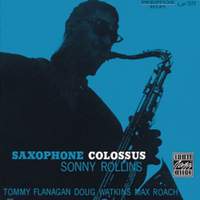Classic Recordings,
Sonny Rollins, 'Saxophone Colossus'

As far as important records of the hard bop era go, there are few as recognisable as Sonny Rollins’ Saxophone Colossus – and indeed what can be said about it that hasn’t already? While the saxophonist’s later record The Bridge that has more of a mythos surrounding it – having been recorded after a three-year sabbatical from recording where Rollins would practice on New York’s Williamsburg Bridge every day – it was Saxophone Colossus that cemented Rollins as just that, a giant on the instrument and one of the contemporary scene’s finest players (if you’re interested to read about The Bridge, you can read my colleague Matt’s writeup on it here).

Saxophone Colossus was one of many sessions that Rollins had done for Prestige Records, having released a handful of records on the label already, and other than Tenor Madness (released only a few months after), it stands out as easily some of the most long-enduring material. Tenor Madness would also, interestingly, be the only time Rollins and John Coltrane would appear on record together. It was during this time as well that Rollins was taking numerous sideman gigs, playing for Miles Davis, Charlie Parker, Thelonious Monk, and the Modern Jazz Quartet – the latter of whom also appeared on his Prestige debut aptly titled Sonny Rollins with the Modern Jazz Quartet, though only on 4 out of the 11 tracks. Still, many listeners’ introduction to Rollins is still his sixth record, released on Prestige in 1956 with a new quartet consisting of pianist Tommy Flanagan, bassist Doug Watkins, and drummer Max Roach – all of whom ran in similar circles to Rollins.
The iconic opening track ‘St. Thomas’ is almost like Rollins’ version of ‘So What’, with just as much recognisability among jazz listeners despite not being written by the man himself – it was Prestige that urged Rollins to take the writing credit for what was actually a traditional folk song. Its calypso-like melody is taken from two folk songs; the Bahamian ‘Sponger Money’ and the English ‘The Lincolnshire Poacher’ – Rollins’ mother would sing this to him as a child, and with both of his parents being from the US Virgin Islands he titled the tune ‘St. Thomas’ after the island of the same name. Just a year before, the tune had been recorded by pianist Randy Weston under the name ‘Fire Down There’, but it would ultimately be Rollins’ interpretation that became a jazz standard and stood the test of time. In the context of the record it also sets Rollins up as a less self-serious jazzer than perhaps some of his contemporaries, and also features one of Roach’s most inventive solos on record. Easily the snappiest tune on the record, with its catchy melody and neat structure you can see why this is one of the longest-enduring jazz standards of the hard bop era.

Naturally, the appeal of Saxophone Colossus stretches beyond just the opening track. The next track ‘You Don’t Know What Love Is’ has Rollins’ take on Gene de Paul’s ballad, and a pretty bold one at that – featuring a brisk solo passage from Flanagan and playing from Rollins that just straddles on the edge of ‘too much’, the two begin to trade lines towards the end; even on the ballads like this it’s entertaining to hear some of the adventurous detours Rollins can take, moments that make up some of my personal favourite spots on the record. The original ‘Strode Rode’, in turn, kicks up the energy with a staggered and syncopated melody, and offers Roach in particular a moment in the spotlight as he propels the quartet through the tune before taking some of the most exciting solos on the record – another equally spirited moment being on ‘Moritat’ (Rollins and co.’s take on ‘Mack the Knife’), where the saxophonist absolutely tears it up in the improv section.
Another of Rollins’s key performances appears on the closing track,‘Blue 7’, which was the subject of an entire essay by composer and theoretician Gunter Schuller, published shortly after the record’s release in 1959 (Schuller was one of the key driving forces behind the ‘Third Stream’ movement, which attempted to fuse modern classical composition with jazz). Analysing Rollins’s improvised solos bar-by-bar, Schuller argued that jazz improvisation is just as capable of the formal coherence and internal logic that is to be found in classical music, and the article certainly helped jazz to be taken more seriously within academic circles. If you’ve spent any time trawling through lists of jazz ‘essentials’ there’s a 100-percent chance you’ll have seen Saxophone Colossus crop up a good handful of times, and they’d all be correct in recommending it. One of the most succinct records of the hard bop era, Saxophone Colossus has all the essential ingredients; catchy melodies, exciting performances and well-curated variety, and excels in every aspect.
Available Formats: CD, MP3, FLAC



